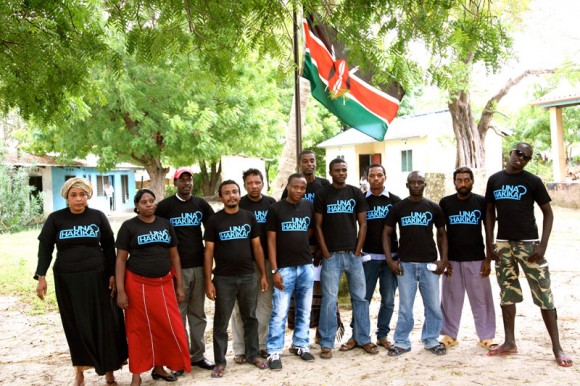 Community ambassadors serve as the human element in the Una Hakika network. Image Credit: Una Hakika.
Community ambassadors serve as the human element in the Una Hakika network. Image Credit: Una Hakika.A good example of a misinformation management system is Una Hakika, an initiative by the Sentinel Project. Una Hakika monitors and counters the spread of misinformation that leads to violence in the Tana Delta region of Kenay. It works in the following way: users send rumour reports which are then verified by community ambassadors (volunteers in each village that have community networks and are able to verify information), other NGOs in the area, local government authorities and local security officials. Once feedback is collected from these sources, accurate information is relayed back to the users in a targeted manner in order to mitigate violence that could ensue. The potential of IT to bridge information gaps in less developed areas is considerable, particularly in contributing to stability, security, and peacebuilding in conflict areas.
Key lessons learned so far include that:
• Misinformation management systems cannot be imposed from above. Instead, they must be implemented by entering into communities using culturally relevant introduction processes, followed by cooperative efforts.
• Misinformation management efforts should not try to replace existing communication practices in a new environment. Rather, they should adapt to the variety of high tech and low tech methods already used in the area.
• Establishing and maintaining trust is one of the most important but also most difficult components of a misinformation management project. A project that is not transparent, honest, and fair will immediately lose its value to the community it serves.
• Women, youth and marginalised communities have the most to gain from a system which can circumvent many of the social, cultural, and structural barriers that prevent them from accessing reliable information.
The impact of good - and bad - information
The Ebola crises in West Africa led to the victimisation of people and deaths because of misinformation. A study by Oyeyemi et al showed that 58.9% of the tweets had medical misinformation and that misinformation had a much larger potential reach than correct information. Misinformation ranging from how to cure Ebola, its source, and handling Ebola patients was rife. Examples include “Ebola can be cured using saltwater baths or cola nuts”, “Poisoned wells caused the deaths of people and not Ebola,” or “Ebola is a government conspiracy to depopulate Sierra Leone’s Kailahun district leading to resistance of the arrival of health workers in the region.”
With a misinformation management service such effects can be reduced by people who have access to facts. This also took place in the US where the first case of Ebola caused misinformation to be propagated, spreading the idea that Ebola was rampant. This shows that misinformation has a powerful effect.
Burundi could also benefit from such a service. With the repression of mainstream and social media there has been a lack of verifiable information. This has caused uncertainty which in turn has led to fear, unrest and insecurity. Such a service coupled with other peacebuilding efforts can fill the information gap allowing citizens to live well-informed, secure and peaceful lives whilst enjoying civic participation.
The European migrant crisis, aside from being fuelled by foreign policy, has been worsened by misinformation, which has created a rift between refugees and local people. The cause of misinformation can be attributed to differences in culture, vested interests, and fear. Social media has contributed to the situation by allowing faster spread of misinformation and allowing a wider reach. Examples include anti-migrant incidents such as the one witnessed in Leipzig where some protesters branded banners that said "Islamists not welcome" and "Rapefugees not welcome" or "Islamic State (ISIL) are sending hundreds of thousands of their soldiers to Europe by infiltrating the refugees." Such comments can fuel conflict. A misinformation management system can map and track misinformation, allow misinformation to be analysed for better policy making and inform people with facts.
A full report can be found here.






